Hot Water Diversion Update 2023!
Hot Water Timers and Hot Water Diversion has been a topic surrounding solar systems since the option became available. The idea is simple; when installing solar you remove your electric hot water system from your off-peak meter, and instead run it on your main meter – T11 (which is what the solar is connected to) – and time it’s heating to coincide with the solar production hours. This used to be done simply with a hot water timer – the dumb method, but now can be done using an inverter’s “Load Management” function – the smart method. There are other options, but we’ll touch on them in future posts. This post simply aims to cover both methods, and why, as a result of increased feed-in tariffs, Solar hot water timers, and the Fronius Hot water relay, are dead.
I wrote this article way back in 2018, and a lot has changed. I would say hot water diversion – if done right – has made a huge comeback. This is due to three main reasons:
-
- Reduced Feed-In Tariffs
- Single Phase Export Limiting
- Newer, smarter, cost-effective options
In this updated post I’ll keep the original concept of hot water diversion intact, but the end of the post is where the 2023 update comes in.
The Solar Hot Water Timer
With a hot water timer, installers set the timer up to come on for a set amount of hours during the period when they expect solar production to be at its highest, and when they expect the homeowner will be sending the most power back to the grid. The problem here is, it’s not guaranteed that period will always be the time of highest production due to rain or clouds, and the homeowner may have different usage habits on different days. If the period where the timer flicks on, is not when enough surplus power is being generated, the hot water will be heated from the grid, at the increased T11 rate. In this case, you can often lose money installing timers, hence, the dumb method. Surprisingly, many sales companies in Brisbane are still selling hot water timers as load control. I’ll give an example later in this post of why it’s not an ideal method.
The Fronius Hot Water Relay
Now for the smart method; using the Load Management Function of an inverter. The best one on the market is the Fronius Inverter’s Data manager card connected with a third-party relay. For simplicity, we refer to this as the Hot water Relay, and it’s the method we use (well, used, but I’ll get to that). The way it works is when a Fronius hot water Relay and Fronius Smart Meter are integrated into a solar system, they have the opportunity to smartly decide when the hot water unit turns on. The hot water relay is able to use the information from the smart meter to identify when a system is sending a large excess back to the grid. When that excess exceeds the kW demand of a hot water unit, it tells the hot water unit to switch on. When the excess is under the kW demand of the hot water unit, it turns off and tries again later. Below is a nice example of a hot water relay in action:
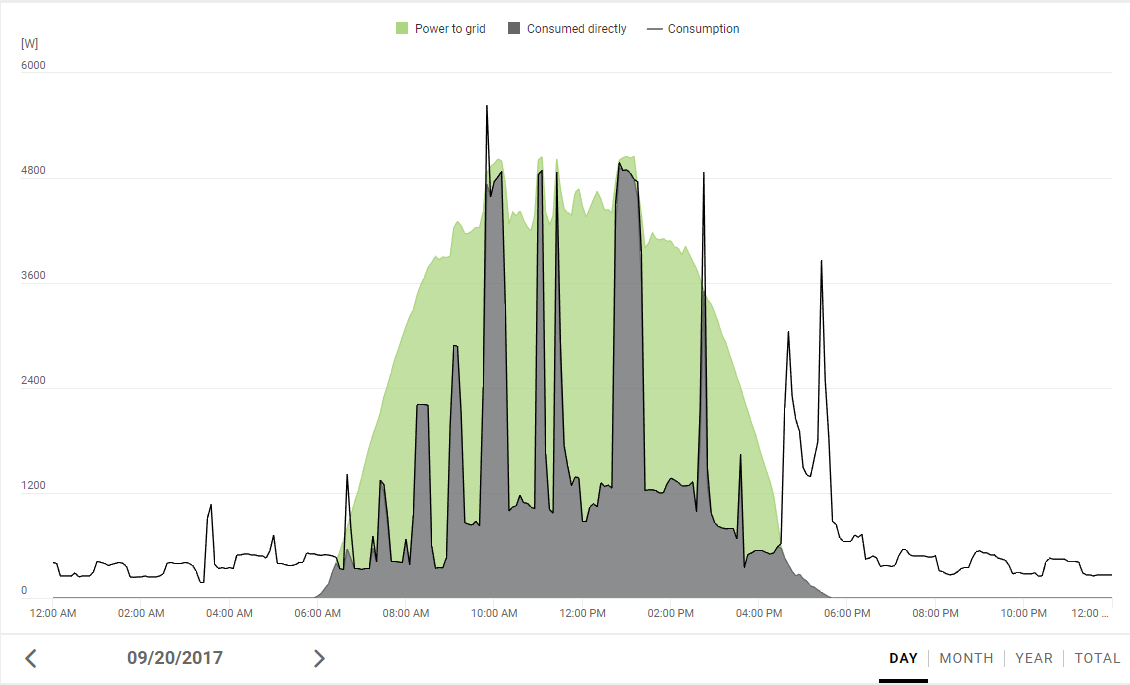
The green is our solar production, and the filled-in grey is our household load. The large spikes are the hot water unit turning on, and you can clearly see the hot water relay controlling the unit to only turn on when the solar production is at its highest, and when it knows it won’t need to draw from the grid. This is very beneficial on cloudy days, on days that may have morning rain, or basically for any household that has varying day-by-day usage habits. However, the hot water relay, like a hot water timer, still requires excess solar production equal to the full capacity of the hot water unit (meaning a 3.6kW hot water element will require the full 3.6kW of solar production all at once), and as such on rainy days, when the excess is not there, it will need to draw a portion from the grid to ensure the hot water unit receives heating just like a hot water timer.
Below is a good example of the hot water unit working well early, but then it hits a time when it can no longer wait for excess solar production, and it needs to draw from the grid. The unfilled section is bought from the grid at the highest rate ( T11, 27c/kWh) :
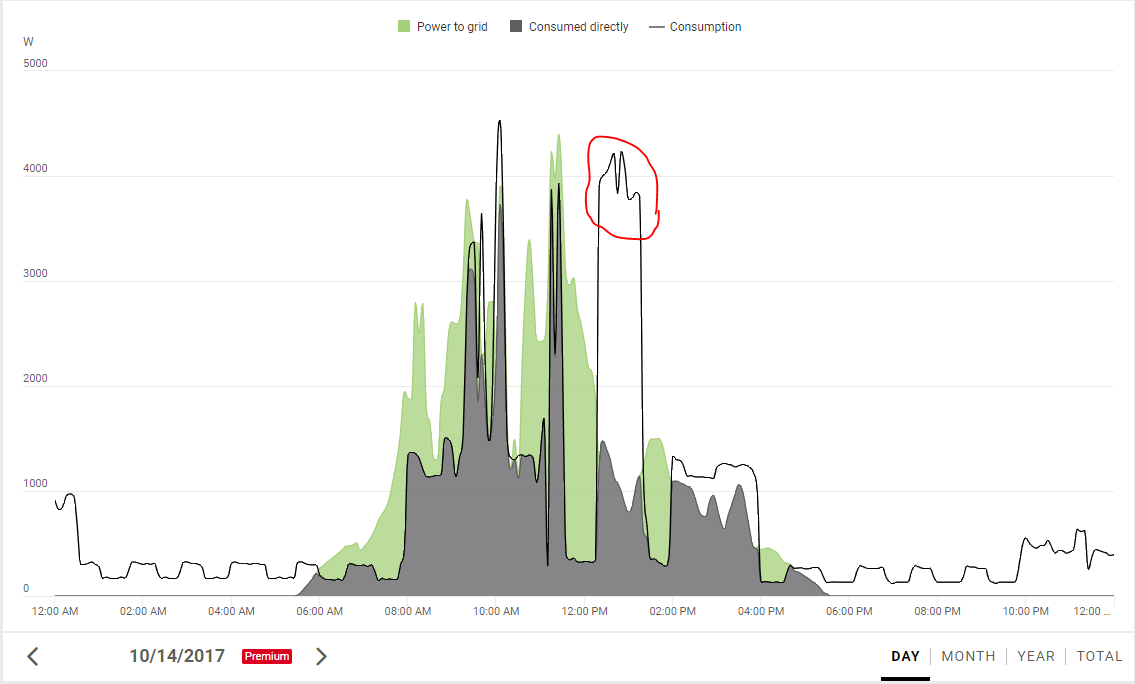
Who killed the Fronius hot water relay?
Using a portion of T11 power from the grid used to be fine, as it is far superior to a hot water timer, and even with this occasional draw from the grid at the increased T11 rate, they still made financial sense. A hot water timer may help a hot water unit achieve 50% coverage from solar, while a hot water relay may achieve 70%. They both cost the same, and the hot water relay is actually more reliable. However, as good as relays are, since July 1st 2017, they rarely make financial sense.
Feed in tariffs
On July 1st, 2017, feed-in in tariffs greatly increased, in some cases from 6c per kWh to 14c per kWh, so the math behind hot water diversion becomes more complicated. Below is an example of an Excel spreadsheet calculation of a hot water relay’s payback period on a 6c Feed In Tariff – what it used to be. Most of the values we can read directly from a power bill, but the section we estimate is the percentage of the excess hot water kWh draw that will be covered by the solar + relay combo. In the below case, we estimated the hot water relay will account for 70% of the heating, and the remaining 30% resulting from rainy days, higher base load etc, will need to be drawn from the grid. The calculation importantly takes the feed-in tariff into account, as we have to remember the excess used to heat the hot water unit could have been sent back to the grid for 6c per kWh:
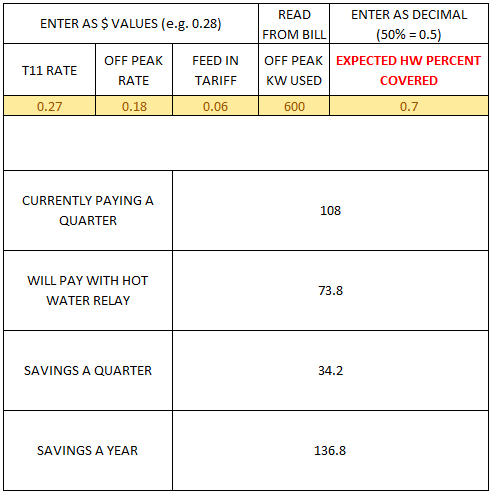
$34.20 better off a quarter than the off-peak rate, $136.80 better off a year.
However, the calculation becomes worse the higher the feed-in value becomes. Below is the exact same estimate, but calculating off a 14c feed-in Tariff instead (Origins Solar Boost rate as of July 1st 2017):

With a whopping $2.40 a year in savings, you’d have to be a pretty good (corrupt) salesman to convince someone to proceed with this kind of payback period. And just for an extra laugh, let’s look at a timer’s current payback period:
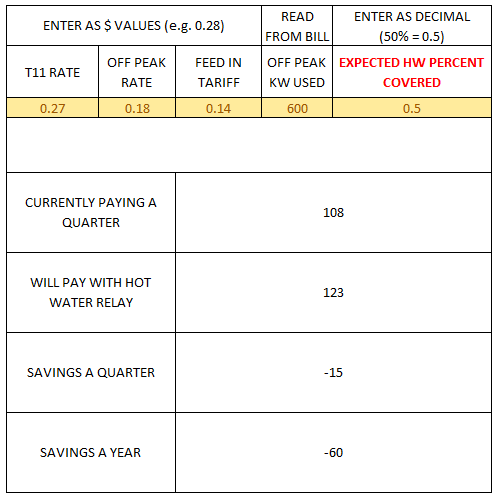
I’m probably being generous anticipating a hot water timer to cover 50% of the hot water heating, but even if it does exceed expectations to say 60%, you’re nearly always guaranteed to lose money if you install a timer.
Is the Fronius hot water relay dead?
No, I’d say it’s more like semi-retirement.
(Incidentally, its role has been replaced by the Fronius Ohmpilot, but that’s for another post).
But there are still plenty of situations where the Fronius hot water relay may be of use. For example:
-
- Feed-in rates are not guaranteed
- Off-peak rates may increase
- If you have a 10kW system, your solar may cover more than 70% of the hot water heating.
- It may not be viable to connect your hot water system to off-peak.
However, it’s still important to have a chat with a solar consultant, work out your household loads and times they’ll come on, run through your bill, and work out if removing an off-peak meter in favour of a relay is worth it. This is what we’re here for, and we’re constantly re-evaluating market changes to ensure when we come out to quote, we are offering the best, up-to-date advice.
Update 14/10/2021 – Solar feed-in tariffs have been dropping lately and so the “Fronius Hot Water Relay” or “Ohm Pilot” is getting closer to being a smart option again. Since feed-in tariffs go up and down all the time, it’s probably still a better choice to keep your hot water on off-peak!
And remember, if anyone tries to sell you a hot water timer, run for the hills.
2023 Updates – Let’s begin the resurrection!
Reduced Feed-In Tariffs:
Looking through the above article, it’s quite clear to see that the whole idea surrounding the viability of hot water diversion was attached directly to the feed-in tariff. My sums above show 14c feed-in tariffs to discredit hot water diversion, a tariff rate that is quickly becoming a thing of the past. Brisbane is currently seeing an average 3-8c feed-in tariff offer, which when you refer to my first calculation, would result in $138 yearly savings with a hot water relay. So, tariffs are reduced, install relays on every job again, right? Well, not quite…
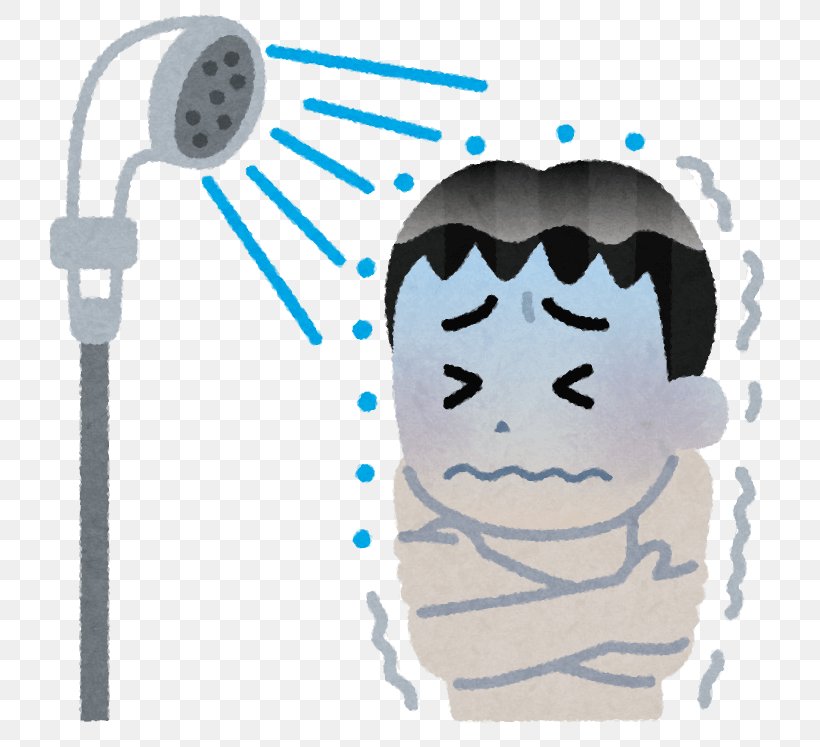 Cold Showers:
Cold Showers:
Hot water relays are much smarter than timers when it comes to optimizing your solar energy. However, it’s their smarts that cause their #1 problem – cold showers. One day you could have your hot water system fully heated by 11 am via perfect solar conditions. Then the night-time showers commence, and the hot water system does not heat up because, well, it’s night time and there’s no excess solar generation to pull from. Then the next day it’s cloudy and overcast, and your relay does not kick in hot water heating until its default “emergency heating” parameters are met by 5 pm. This means you have gone for 30 hours of no hot water heating, something few households can withstand. I’m also apparently told if you have any teenage girls, you’ll be hard-pressed to even survive the night!
Cold Shower Fix:
The fix would be to restrict the parameters of the relay to ensure it always heats by 10 am, but then by that point, you might as well go for a simple timer – it’s cheaper and does the same thing. It also has the added benefit of a “boost” function (something absent in the relay) allowing for nighttime heating. However, this nighttime boost will come at the cost of standard electricity rates – 29c – as opposed to the much more attractive off-peak electricity rates of 18c. So if you require frequent nighttime boosts, haven’t you just defeated the point of changing your hot water optimisation?
As you can see, feed-in tariff changes alone do not completely resurrect the hot water timer or hot water relay. On paper, their new calculations look good, but in reality, boosting and cold showers really defeat the purpose. This is where we enter, export limiting.

Export Limiting:
I wrote an article a while back on the grid regulation changes to system sizes on single-phase premises. In short, you can exceed 5kW inverter limits as long as you don’t send any more than 5kWh of solar back at any one time. This means if you have an 8kW system that is producing 8kW, and no loads for the solar to power, it’ll produce and export just 5kW. So in this instance, you would need to have an average load amount of 3kW (8kW minus the 5kW export limit) to financially justify the installation of this 8kW system. Most households since the impact of Covid-19 have been able to do this via more days of working from home, and average solar system sizes have skyrocketed as a result. However staying on topic, export limiting on a single phase has also opened the door for hot water timers and relays. Why not activate hot water heating at precisely the time your system is hitting an export limit of 5kW?
This is huge. Suddenly we’re not talking about feed-in tariffs of 14c, and we’re not even talking about feed-in tariffs of 6c. We’re talking about potentially 0c tariffs. If you export limited to 5kW but have a system capacity generation of 8kW, you’re missing out on 3kW (for multiple hours in the middle of the day) which can easily be soaked by a hot water system. Now, as you might know, I’m a visual kind of guy, so let’s try to explain my excitement with some images:
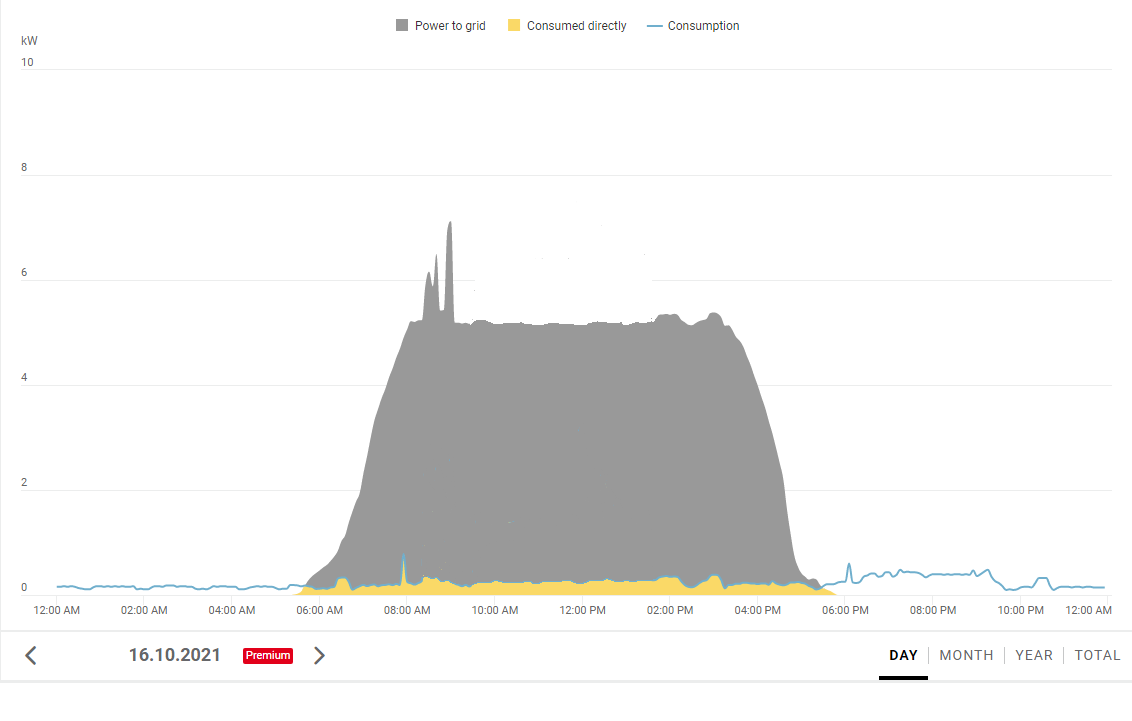
The above is actually an 8kW system, but export is limited to 5kW. As you can see, the system is unable to reach its full capacity because there is no household load to stop it from reaching the 5kW export cap. The grey section is not allowed to be greater than 5kW due to Energex grid restrictions. Let’s say this household also has an off-peak electric hot water system. They have a 3.6kW element which is heating for roughly 2 hours at night, for the reduced tariff rate of 18c per kWh. That’s $1.29 a day, or $120 a quarter – just for the hot water! Now, let’s pretend we add a hot water timer to this household:

Although the graph is different, it’s important to note this is the exact same system. It’s producing more power because the household has a hot water load coming on in the middle of the day, so our restrictive grey section is able to reach its full capacity of 8kW, as the 5kW limitation has shifted. Once the hot water has reached its desired temperature by 12pm, you’ll notice the system ramps itself down again to adhere to the 5kW export limit requirement again. In this instance, the hot water was completely covered by the solar generation that it otherwise would not have been able to utilise, effectively saving the full $120 per quarter.
Of course, this is a perfect example for simplicity’s sake. You are going to get rainy days, periods of high usage, etc., so the savings won’t be this consistently high. However, even if we go as far as to halve these savings (as I did in my original hot water efficiency calculations) that’s still $60 savings a quarter, or $240 a year – well above my high-end 2018 example of $136 a year.

It’s important to note the ability to capitalise on export limiting hours must be achieved by a timer, not a relay. A relay, while optimal, uses your solar data for the entire day to maximise the hours it heats up the hot water unit. This means it could be using hours before export limiting has taken effect, or after export limiting has taken effect. Basically, morning or late afternoon. These are the hours you could be exporting for 6-8c. So, the calculations and savings are not as optimal as the hours of export limiting, when the feed-in tariff is effectively 0c. Also, as previously mentioned, the timer has the added benefit of boosting itself for nighttime heating in times of high hot water usage. This is something a relay cannot do. While you’d want to minimise this nighttime heating to increase savings, there is still a lot of leeway in doing so now compared to before, as our savings are looking well above $200 annually.
The Dilemma
Of course, we enter the dilemma of installing a large size simply for the sake of hot water heating. Why not save money and go smaller? To a size more suited to your other electrical appliances, and retain the off-peak hot water rates? This question has no generic answer, it will vary from household to household. In short, if you have a roof that is easy to increase from 5kW to 8kW~, and therefore the cost to do so is small, then it’s probably a good idea. However, if your roof makes the design from 5kW to 8kW difficult, and therefore extremely costly simply for the sake of covering a hot water load, then it’s probably not a good idea.
Putting it All Together
So now we have export limiting, on top of the reduced feed-in tariffs. I don’t feel one or the other would justify a hot water timer by itself, but combining both together it’s hard to ignore hot water diversion is making a comeback. However, I can’t help but feel the story of hot water diversion is not complete yet. We are forced to install a “dumb” timer to make sure we don’t have cold showers. This dumb timer also has a very limited warranty, which feels disconnected from a high quality system. We’re forced to use it in the hours of export limiting without any room to adapt to your usage habits. Seems a waste of how smart the future is supposed to be. Watching your solar system un-optimally power such a large, expensive load. What if there was a device that could:
-
- Turn on when you hit the hours of export limiting
- Respond to load and weather changes to draw optimally from your solar, and
- Boost at night to ensure the water stays hot
Well now in 2023, there is – The New Catch Power Relay.
This is the device we’ve been waiting for, and after some testing / financial analysis, we’ve added it to our range, and are installing them on nearly every single phase household that has an electric hot water system. I’d recommend reading this article for more information, or the below video if that’s more your thing:
We acknowledge the landscape for hot water diversion has improved over the years, but it wasn’t until now that we’ve been satisfied with the answer. Export limiting, reduced feed-in tariffs, and now this new Catch Relay, have all come together to provide the answer. Those looking to maximise their solar system, and save even more money on their power bills by optimising one of the largest electrical loads, can now do so. Stay tuned, and as always, feel free to leave any comments below and I’ll be happy to answer.
Ben Neville
Sales Designer / Estimator
MC Electrical



















